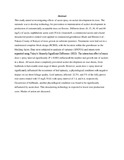Effects Of Auxin-dose And Spray-interval On Sucker Development In Rose (rosa Hybrida L.)

View/
Date
2011Author
Musembi, N. N.
N., Adeya
W.W., Murigi
Type
PresentationLanguage
enMetadata
Show full item recordAbstract
This study aimed at investigating effects of auxin spray on sucker development in roses. The
rationale was to develop technology for prevention or minimization of sucker development in
production of commercially acceptable rose cut flowers. Different doses (0, 15, 30, 45 and 60
mg/L) of auxin, naphthalene acetic acid (NAA) (Anatone®, a commercial auxin) and a hand
desuckered positive control were applied in commercial greenhouse (Buds and Blooms Ltd -
Nakuru County of Kenya) of roses grown on substrate (pumice). Treatments were laid out in a
randomized complete block design (RCBD), with the location within the greenhouse as the
blocking factor. Data were subjected to analysis of variance (ANOVA) and means were
separated using Tukey’s Honestly Significant Difference (HSD). The interaction effect of auxin
dose × spray interval significantly (P < 0.001) influenced the number and growth rate of suckers
in a shoot. All auxin doses completely prevented sucker development on rose shoots, from budbreak
to harvestable stem stage of shoot growth. However, auxin dose × spray interval
significantly influenced the occurrence of leaf epinasty, a physiological condition with negative
impact on cut shoot foliage quality. Leaf epinasty affected: 22.5%, and 5% of the fully grown
rose stems treated with 15 mg/L NAA with spray interval of 1 d, and 6 d, respectively.
Occurrence of bullheads, another physiological condition was found to be significantly
influenced by auxin dose. This desuckering technology is expected to lower rose production
costs. Modes of action are discussed.
